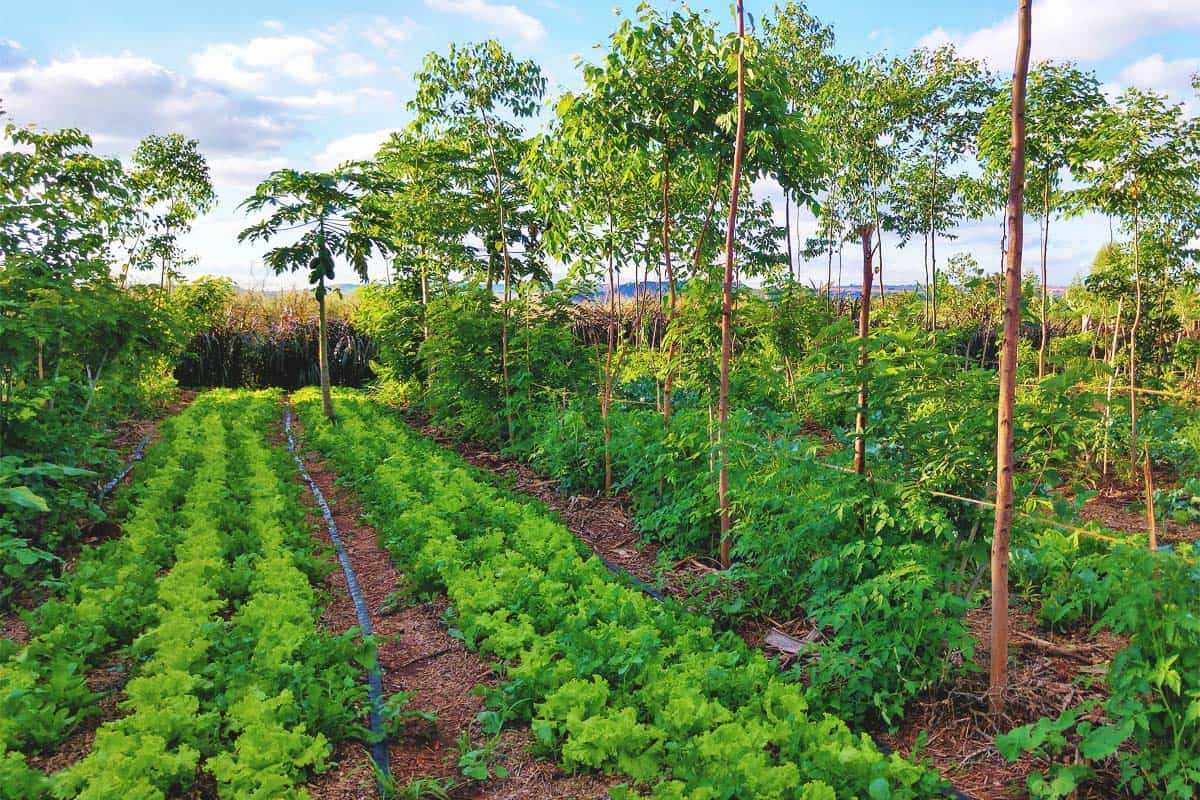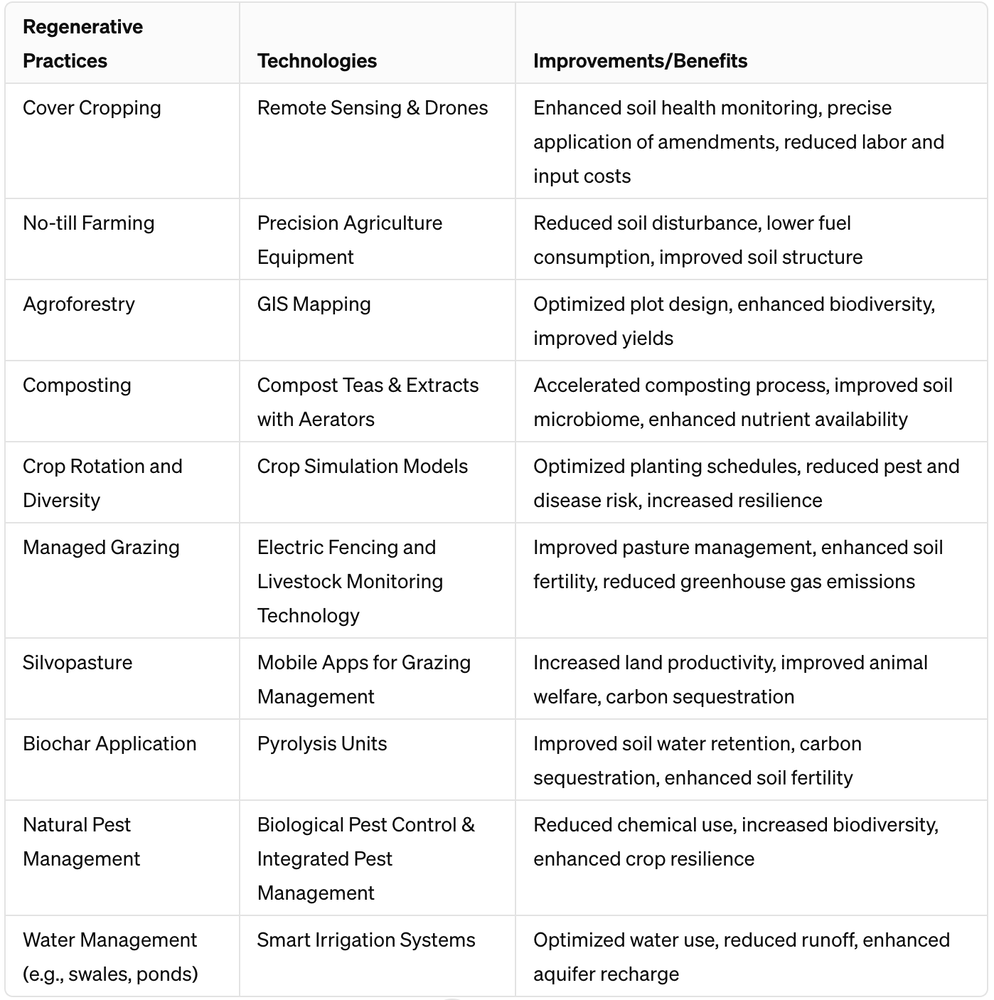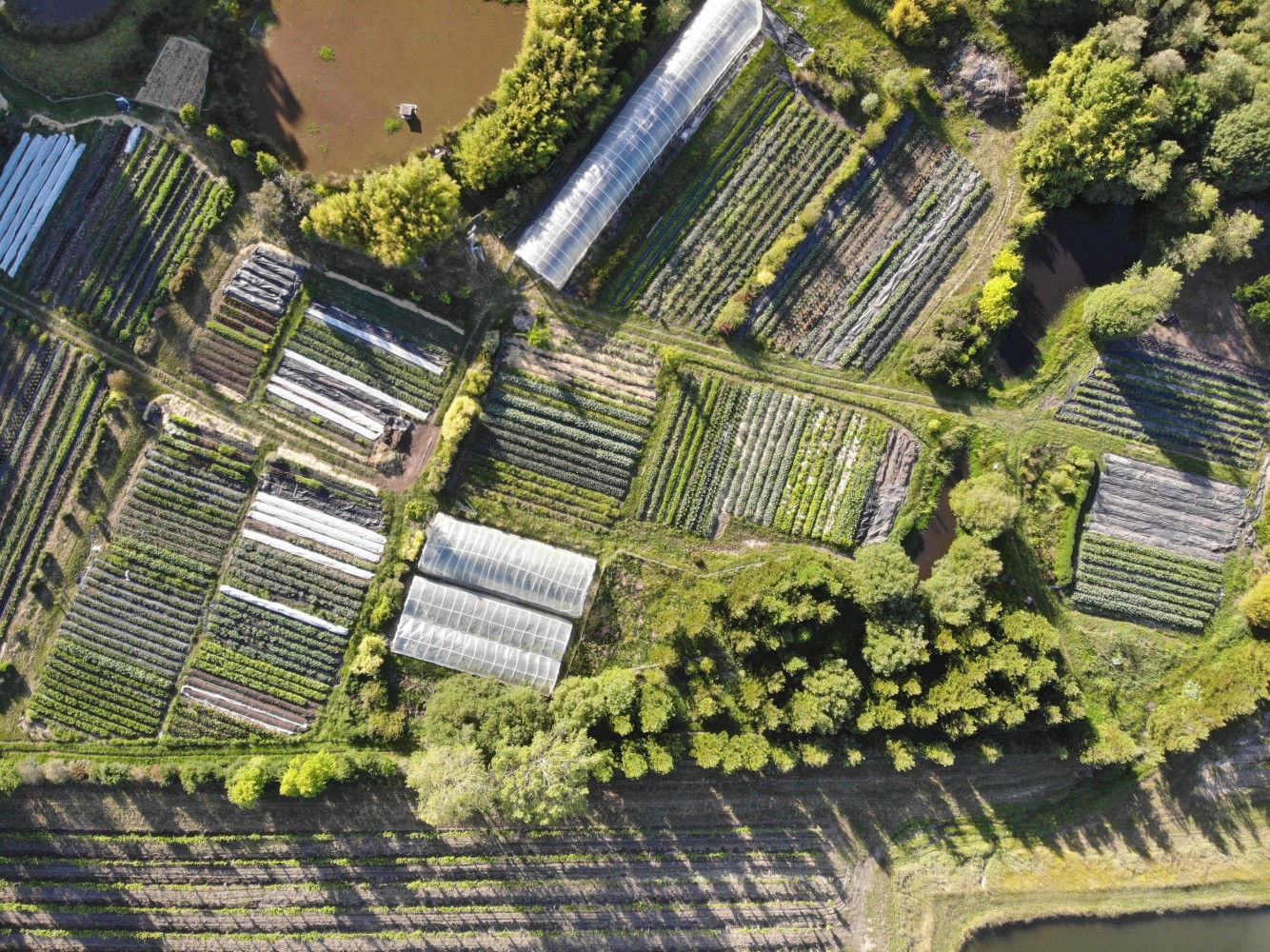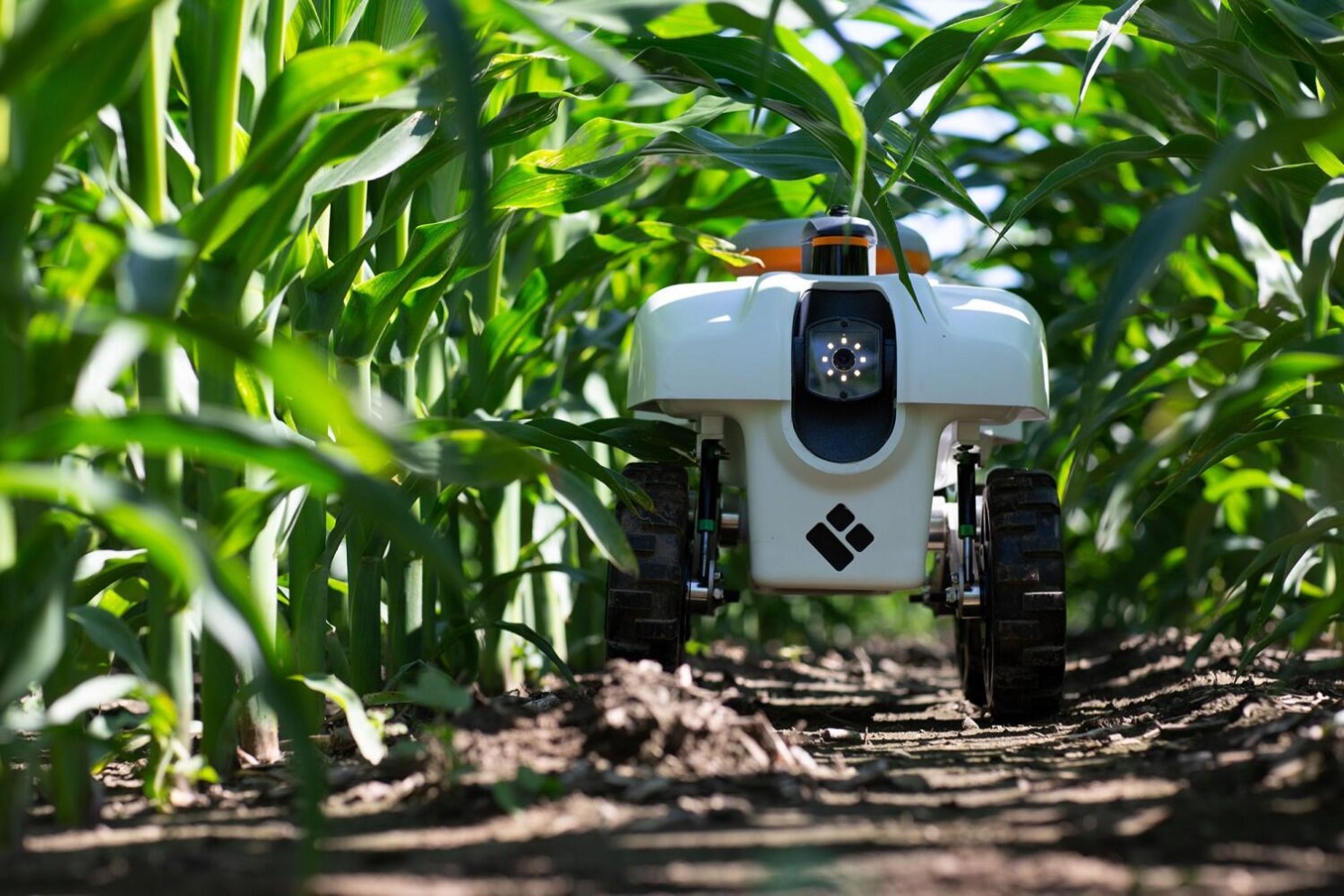Apr 7, 2024
A Vision for Technology in Regenerative Agriculture

April 7, 2024 (Image source)
The escalating climate crisis we are currently facing demands innovative and impactful solutions across every sector, agriculture being one of the most critical. Rooted deep within the agricultural sector are detrimental issues contributing massively to environmental degradation. Here, regenerative agriculture , termed as 'regen ag', emerges as a beacon of hope, an answer possibly capable of reversing the environmental imbalance. This form of agriculture promises not just sustenance, but restoration of our planet's health through an assortment of sustainable farming practices that consider the vital components of the ecosystem.
As this groundbreaking approach gains momentum and international recognition, the optimism surrounding its adoption is palpable. However, it is equally vital to address the existing doubts and apprehensions surrounding its execution. The profitability and scalability of regen ag, its scientific backing, the impact it could have on the farming community, and its anticipated reception within the investor domain are all questions that bloom amidst this paradigm shift in farming.
This article shares my own exploration of regen ag's viability, aiming for a balanced examination. We will take a closer look at its impacts on farmers, it's expected growth and perception within the investment community. I review common criticisms and provide the sector's rebuttals. Additionally, a visionary outlook on the amalgamation and hybridization of regen ag with the uptrends of technology will round out my overview. Join me in this exploratory journey about a movement that may just revolutionize our relationship with the earth.
The nation that destroys its soil destroys itself. - Franklin D. Roosevelt
Why Regenerative Agriculture?
Regenerative agriculture, is more than just a convergence of specific farming techniques. It is a profound philosophy dedicated to reenergizing and restoring not only soil health, but the entire ecosystem. A fundamental pillar of this philosophy is the belief in the Earth's innate capacity to restore itself. Every regen ag practice, therefore, prioritizes key elements like soil health, biodiversity, and the renewal of water cycles, all of which contribute to this natural healing process.
Regen ag represents a paradigm shift in agricultural methodology that even Forbes claims to be economically beneficial. Investors are getting more interested in regen ag because it can not only improve the profitability of farms but also reduce input costs amongst other financial benefits. Regenerative farming can reduce pesticide use by 50-100%. The dream that we want to become reality here is that sustainability doesn't have to be at odds with profitability. On the contrary, by fostering a more holistic approach to farming, we're placing ourselves on a trajectory toward greater economic sustainability, while simultaneously aiding in environmental restoration.
In concurrence with Forbes, Project Drawdown, a renowned environmental organization, categorically lists regenerative agriculture as a top-ranking solution for carbon sequestration. They estimate that for every hectare regenerated through this practice, there's a potential profitability of $530.39 per year. This compelling data brings to light the dual benefits that come hand in hand with adopting regenerative practices. Ecological sustainability doesn't need to spell financial downfall, as is often feared. With regen ag, we witness a merger between economically beneficial practices and environmental conservation - a rarity in many industries. It's estimated that such practices can lead to increased crop yields and resilience against climate impacts, thus further securing economic gains.
In this regenerative model, practices such as recycling, regular application of compost or biochar, and cultivating crops that actively capture carbon from the atmosphere, play a vital role. These techniques not only assist in soil restoration but also contribute to an overall healthier and more robust ecosystem. This not only benefits our environment but has credible potential to bolster economic success in the farming sector, breaking the stigma often associated with environmental sustainability. Regenerative agriculture can increase soil carbon stocks by 1-3 tons/ha/year.
Benefits of Regenerative Agriculture on Farmers
Regenerative agriculture comes as an innovation in farming practices, focusing on the rehabilitation and restoration of the soil used for agriculture. It presents a compelling case for farmers, with the prospects of improved long-term land productivity and resilience against climate change. However, the transition isn't as easy as it sounds. There are challenges that need to be braved, including acquiring new knowledge and skills, as well as potentially investing in new equipment. There is also risk of temporary yield loss and impact on farm-level revenue. However, these are mainly short-term pains that pave the way for long-term gains.
In a study conducted by CSU Chico, it has been found that integrating regenerative agriculture into mainstream farming has the potential to restore the water cycle, which significantly contributes to the overall health and longevity of the soil. This transition also helps in carbon sequestration, actively helping in the fight against the dire impacts of climate change.
Another study from DTNPF also showcases how regenerative agriculture can be beneficial. It found that these practices drastically reduced the input costs involved in farming, while concurrently enhancing the yields. Practices such as recycling, the regular addition of compost or biochar, and cultivating crops and vegetation that capture carbon from the atmosphere are essential components of regenerative agriculture, according to the study. Regenerative farming can reduce pesticide use by 50-100%.
All this data points to a future where agriculture works hand-in-hand with nature, which could lead to increased profitability and sustainability for farmers. The potential rewards, such as healthier soils, increased biodiversity, and reduced emissions from food systems clearly outweigh the challenges in view of many farmers who are making this transition.
We must invest more in regenerative agriculture sooner rather than later. It is essential to look at regenerative agriculture not just as a farming trend, but as an investment in our long-term future. The process might entail initial prospective challenges, but the long-term benefits for our planet are innumerable and the expected returns for the farmers, lucrative.
Interest from Investors
The prospect and potential of regenerative agriculture has undeniably caught the attention of the financial world. Investment in regenerative agriculture is being propelled by numerous factors including an overall paradigm shift towards sustainability, the promising prospect of long-term profitability, and an attractive opportunity to mitigate risks related to climate change. Acknowledging the significance, Boston Consulting Group (BCG) has identified regen ag as a burgeoning sector with a vast potential for investment.

Furthermore, Forbes also highlighted this growing interest from investors within their in-depth reports. Their analyses outline the considerable benefits of integrating regenerative practices into modern farming for both the environment and the economy. According to Forbes, regenerative agriculture can function as an investment that caters to the broader principles of environmental and social governance (ESG) strategies. Hence, it's distinctively comprehensive approach to modern farming practices and sustainability has made it an attractive funnel for capital investment.
Main Criticisms of Regenerative Agriculture
Regenerative agriculture, despite potential benefits including improved yields, resilience against climate impacts, and reduced emissions from food systems, comes under scrutiny from critics, primarily bounty its scalability, the inherent risks associated with transition, and debates surrounding its scientific basis.
The scalability critique leans heavily on the contrast between small-scale farms and vast commercial agricultural enterprises. While naysayers acknowledge the benefits regen ag practices bring to small-scale farms, they raise eyebrows when discussions arise of applying regen ag on a broader spectrum or larger scale. The core argument centers around the feasibility of making such a mammoth transition from conventional farming, given the enormous initial investments required and the imminent risk of decrease in predictability and yields, at least initially.
Another point of criticism lies in the risks related to transitioning from conventional methods to regen ag. A transition to regen ag is seen as challenging due to numerous risks including temporary yield losses, lower farm-level revenue, and potential long-term damage to productivity and income. Many critics posit that not all farms can afford the proverbial leap into the dark associated with transitioning to regen ag.
Additionally, critics often point out that smallholder farmers might find the transition especially daunting owing to their limited capacity and resources. These farmers often lack the financial robustness to weather short ebb in the productivity or revenue, heightening the financial risks associated with the transition for them. However, it's important to note that organizations are cropping up that work to help smallholder farmers make the transition more smoothly and affordably.
Furthermore, a lack of consensus on the science behind regen ag also serves as a common point of critique. Detractors suggest there is little empirical, large-scale data available to unequivocally support the touted benefits of regen ag. Despite various studies showing the positive impacts of regen ag on soil health, carbon sequestration, and biodiversity, critics argue these findings are often specific to certain climates or soil types, and not universally applicable.
Investment potential of regen ag tech and public-private partnerships in sustainable agriculture too, come under some scrutiny. While government investment in the U.S. may be smaller than the private market investment in food and ag tech, the relationship and favorability between the two is viewed as crucial for advancing regenerative agricultural practices. Critics argue that the significant amount of private capital required for these ventures may narrow the scope of engagement, exclude marginalized communities, and inadvertently reinforce existing inequalities in access to regen ag tech and resources.
Considerations of the Indigenous Roots of Regenerative Agriculture
Among the pool of criticisms, ethical concerns related to co-opting regen ag also emerge, particularly in regards to its indigenous roots. Critics often argue that the surge in popularity of regen ag has led to cultural appropriation of indigenous farming methods, without due acknowledgement or understanding. These traditional techniques have been practiced by indigenous communities for centuries and have an entrenched spiritual and socio-cultural significance. The appropriation of these techniques by commercial entities or the western agricultural model, often without sufficient credits, respect or returns to the native communities, raises important ethical concerns. It's important to facilitate dialogue about these issues and establish a fair practice that honors the original holders of this knowledge. Through mindful recognition of indigenous contributions to regenerative agriculture, and incorporating them into a fair share of its economic profits, we can begin to address these cogent ethical concerns.
Rebuttals and the Viability of Regen Ag
Despite harboring some criticisms, there is considerable evidence showing the effectiveness of regenerative agriculture, as well as its potential for considerable profitability. A plethora of success stories and comprehensive scientific studies clearly demonstrate regenerative agriculture's ability to improve soil health markedly. One key approach is the use of Conservation Tillage, a remarkable technique that covers the surface of farming soil with crop residues. This strategy has been proven to not only renew and restore soil fertility, but also to help reduce soil erosion, dramatically improving the quality of the land over time.
Furthermore, regenerative agriculture has been observed to enhance biodiversity quite significantly. The process of Conservation Tillage fosters a conducive shelter for small animals, which creates a healthy ecosystem and improves biodiversity. By applying regenerative farming practices, farmers can foster biological diversity on their lands, which is instrumental in maintaining the overall health of the planet.
Moreover, regenerative agriculture's role in increasing water retention is significant. It rehabilitates and restores the water cycle, contributing to the overall resilience and vitality of the soil. These methodologies help return farming lands and barren territories to a healthier state, demonstrating regenerative agriculture's powerful capacity for land rejuvenation.
Regenerative agriculture also exhibits extreme resilience against the odds - from climate extremes, in particular. Compatibility with various geographic and climatic conditions has made it a proven solution for mitigating the adverse impacts of climate change on farming and soil health. This unique attribute not only counters the prevailing criticism of scientific consensus but also highlights the scalability and adaptability of this method across numerous conditions.
A Vision of the Future of Regen Ag with Technology
Reimagining the future of agriculture, it seems, involves the combined power of regenerative agriculture principles and the advanced capabilities of modern technologies. Several industry experts, including our team at Agritecture, envisage an agricultural revolution that harmonizes regen ag techniques with the innovations of green technologies, digital tools, and agrivoltaics. This balanced blend of ancient wisdom and new tech holds the promise of creating an agricultural framework that is both highly productive and sustainable.
What makes this hybridization approach so compelling? The answer lies in the multitude of benefits it offers. For starters, it helps optimize land use. With the United Nations predicting that the world needs to increase its food production by a massive 70% by 2050, it's clear that efficient land use is no longer a choice - it's an absolute necessity. Implementing regen ag practices, backed by digital tools, can increase crop yield per acre, supporting this dire need for increased food production.
But it’s not just about maximizing yields. By integrating these practices, farmers can also significantly reduce their environmental impact. According to a globally referenced research project exploring the corelation between regenerative agriculture and agricultural technology investments, farms practicing regen ag methods are capable of reducing carbon emissions by 8% to 25% on average. When coupled with the implementation of digital tools, the potential for carbon reduction becomes even more substantial because accuracy and automation are improved.
Furthermore, a hybrid regen ag and technology approach paves the way for increased resilience against climate change. By restoring soil health and enhancing biodiversity, regen ag farms are more robust to the vagaries of unpredictable weather patterns. This is especially crucial in today's age when climate change is posing unprecedented challenges to farming communities worldwide.
For farming to remain viable in the future, it must be adaptable and resilient. The adoption and integration of regenerative agriculture principles, coupled with the precision and efficiency offered by digital technology, offers an effective solution. It allows farmers to respond better to shifting climate conditions, improve their productivity, and maintain the health of their land for generations to come. This amalgamation of regen ag and advanced technology is shaping up to be not just an alternative, but indeed the future of sustainable farming.
Benefits of Regenerative Agriculture Enhanced by Technology

Examples of Tech-Enabled Regenerative Agriculture
Integrating advanced technologies like IoT, AI, automation, greenhouses, and satellite imagery into regenerative agriculture practices has proven to enhance efficiency, productivity, and sustainability. Here are five additional examples demonstrating this innovative approach:

Case Study 1: Singing Frogs Farm, California, USA
Overview: Singing Frogs Farm is a small-scale, highly productive regenerative farm known for its no-till vegetable farming system, which enhances soil health and biodiversity.
Technology Integration: The farm utilizes IoT devices for precise irrigation control, ensuring that water is used efficiently and only when necessary. Automated weeding robots help maintain the no-till system without disrupting the soil, preserving its health and the carbon sequestered within it.
Outcomes: The combination of regenerative practices with IoT and automation has led to a significant increase in vegetable yields per acre, reduced water usage, and a decrease in labor costs. The farm's success demonstrates how small-scale operations can benefit from smart technology to achieve sustainability and profitability.
Case Study 2: Bowles Farming Company, California, USA
Overview: This is a large, family-owned farming operation that has been exploring regenerative practices to improve soil health and reduce chemical inputs.
Technology Integration: Bowles Farming Company employs AI-driven platforms to analyze satellite imagery and drone data, monitoring crop health and soil moisture levels across different fields. This data-driven approach enables precise application of water, organic fertilizers, and natural pest control methods.
Outcomes: The farm has seen improved water efficiency and reduced reliance on synthetic fertilizers and pesticides, leading to healthier soils and increased biodiversity. The technology also allows for better decision-making and risk management, ensuring higher crop quality and yield.
Case Study 3: The Agrarian Freedom Project, Zimbabwe
Overview: In an effort to combat desertification and restore land, this project employs regenerative agriculture techniques in drought-prone regions of Zimbabwe.
Technology Integration: The project utilizes solar-powered IoT sensors to monitor soil moisture and temperature, optimizing irrigation and planting schedules. Drones are used for mapping vegetation cover and assessing the progress of land restoration efforts.
Outcomes: The integration of renewable energy and smart agriculture tools has led to the successful restoration of degraded lands, with an increase in crop yields and local biodiversity. This case study showcases the potential of technology in supporting regenerative practices in challenging environments.
Case Study 4: VinEco Agricultural Investment, Development and Productions LLC, Vietnam
Overview: VinEco operates high-tech greenhouses and applies regenerative agriculture principles to produce organic vegetables at scale.
Technology Integration: Their greenhouses use advanced climate control systems, powered by AI to optimize growing conditions for various crops. Hydroponic systems reduce water usage, and IoT sensors monitor plant health and nutrient levels, minimizing the need for chemical inputs.
Outcomes: VinEco's use of technology in greenhouses has resulted in year-round production of high-quality organic vegetables, with a significant reduction in water and fertilizer usage. Their model demonstrates the scalability of combining regenerative practices with high-tech solutions in a controlled environment.

Case Study 5: TerraSentia, Global Impact
Overview: TerraSentia is a company providing advanced robotics and AI analysis for crop trait development and phenotyping, supporting regenerative farming practices worldwide.
Technology Integration: The company's autonomous robots traverse fields, collecting data on crop health, growth, and soil conditions. This data is processed using AI algorithms to provide actionable insights for farmers on improving soil health, optimizing crop rotations, and reducing input use.
Outcomes: TerraSentia's technology supports regenerative practices by enabling more precise agriculture, improving crop diversity, and enhancing soil health without increasing labor costs. Their global reach indicates the scalability and adaptability of high-tech solutions in various agricultural contexts.
These examples illustrate the dynamic interplay between regenerative agriculture and advanced technologies, offering scalable, efficient, and sustainable solutions to contemporary farming challenges. Each case study demonstrates a unique application of technology that complements and enhances regenerative farming principles, paving the way for a more sustainable agricultural future.
Regenerative Agriculture and Technology: a Smart Move for a Resilient Future
As we confront the climate crisis, urgency and action should be our guiding lights. Regenerative agriculture, supercharged by technological innovation, offers more than a ray of hope—it presents a pragmatic, actionable path forward. By harmoniously combining the power of tech with the inherent strengths of regen ag, we can bring about sustainable improvements, today, not tomorrow. This approach isn’t just a pipe dream. It's firmly anchored in economic viability, rooted in environmental necessity. It's a pioneering blueprint for a sustainable, prosperous future in agriculture—a vision within grasp that engenders hope!
From AI to IoT technologies, advances in the tech sector are helping to amplify the positive impacts of regenerative agriculture. They improve operational efficiencies, reduce environmental degradation, and increase crop yields, making it a win-win for farmers, consumers, and the planet.
By investing in regenerative agriculture and integrating it with the latest technology, we're not just cultivating a solution for today’s challenges but also sowing seeds for a resilient, nourished, and prosperous future. It's time to embrace the regen-tech revolution!
Agritecture provides a range of services for planning and improving and assessing farms, including those seeking to balance regenerative methods with technology. Contact us to learn more!
